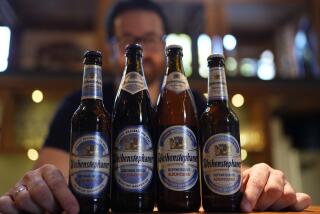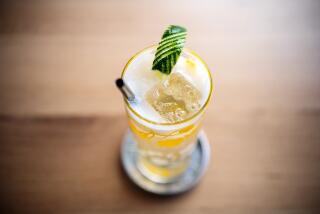Summer’s here, time to drink yellow beer
- Share via
It wasn’t so long ago that straw yellow beer was considered the enemy of the craft beer movement. Light lager represented the unimaginative hegemony of the giant breweries, while pungent pale ales and inky stouts were deemed more flavorful, genuine expressions of the brewer’s trade. But recently, even craft brewers have embraced golden lagers and their related styles. Shelves and tap lists overflow with small-batch Pilseners and blonde ales, and for good reason. The family of golden beers strikes a balance between approachability and character.
These yellow brews of summer are all thoroughly refreshing, with a balance of malt flavor and hop character, a restrained alcohol content and a clean and crisp finish. But what exactly is the difference between a Pilsener, a Kölsch, a cream ale and a blonde ale? Here’s a breakdown of the yellow brews, and why you should give them a try.
Pilsener
It all started with the golden lagers of Bohemia in the mid-19th century. Combining technological advancements from Britain, ingredients from the Bohemian countryside and a new German brewing method, the first Pilsener was a revelation that swept across Europe, and across the Atlantic. Within 100 years, the vast majority of beer made in the world was directly descended from the Urquell (original) Pilsener. A true Pilsener is light and brisk on the palate, but with a richness of bready malt flavors that belie the pale color and a bracing hop bitterness that finishes clean and snappy.
The Bohemian-style Pilseners have a little more body and less hop aroma than the German Pilseners, but American versions have nearly erased this line. At their best, American craft Pilseners are light, dry, brisk and unmistakable hoppy, and one of the best examples is Pivo Pils from Firestone Walker Brewing. Nooner from craft giant Sierra Nevada Brewing hews closer to the German examples, and local favorite Little Bo Pils from Smog City Brewing in Torrance is a particularly refreshing version, though you’ll need to find it on draft.
Munich helles
In the late 19th century, Pilsener fueled a thirst for golden beer across Europe. Brewers elsewhere, especially in the south of Germany, scrambled to copy the Bohemian lagers. In Munich, where the well water is harder and thus the local beers darker, brewers perfected a copy-cat style called helles (German for pale). Helles beer is softer and more malt-accentuated than Pilsener, but it shares the same color and crisp lager finish.
Helles hasn’t caught on with craft brewers the way Pilsener has, but the Bikini Blonde from Maui Brewing Co. is a widely available and excellent example of the round and off-dry profile of a great helles. Or track down a six pack of the seasonal Wheels Up Helles Lager from Redlands’ Hangar 24 brewery.
Kölsch
At the turn of the 20th century, some enterprising brewers in Cologne, Germany, developed Kölsch, a golden brew that used a hybridized strain of yeast that acted like a fast-fermenting ale yeast, but had the clean finish of a lager. Kölsch still gets a period of cold conditioning that results in a clean finish, but there are fruitier esters present in a Kölsch than in a true lager. The traditional examples from Cologne have a rounder flavor than a pils or helles, but they retain a refreshing snap.
Kölsch became a popular gateway beer for drinkers weaned on American light lagers during the early days of the craft beer industry. A true “lawnmower beer,” Kölsch is a thirst-quencher, not a beer that begs to be fussed over. Seafarer Kölsch from Inglewood’s Three Weavers Brewery has a bit more of a hop bite than the average Kölsch, but the brisk finish makes it the perfect beer to pair with barbecue.
American adjunct lager and American light lager
These are the mass-market beers, the Buds and the Coors and the Miller Lites, the “fizzy yellow lagers” that were the targets of craft beer invective for the past 20 years. The style emerged after Prohibition ended in America and is marked by the use of “adjuncts” — such as rice or corn — to lighten the body and mellow the flavor, compared with a beer made with all barley. There’s hardly any hop character present, and nearly no bitterness. With a low alcohol percentage, these are beers built to drink by the caseful and not draw any more attention to the liquid
Try Eagle Rock Brewery’s Don’t Maize Me Bro lager, brewed with toasted rice instead of the more common flaked maize.
Cream ale
Just as Kölsch is an ale adaptation of the Bohemian lagers, cream ale takes the American light lager and adapts it with an ale yeast. The result is a fruitier aroma and a finish that’s sweeter and lingers longer than a lager. Another style popular in the early days of craft brewing, the cream ale can be made with all barley, or lightened with corn or rice. (Despite the name, no dairy is used to make the beer.) Generally there is little hop flavor and only the vaguest suggestion of hops in the aroma.
Foam Top from Beachwood Brewing is a superlative example of the style, and it’s now available in six packs. A less traditional, trendier example is Cali Creamin’ from Mother Earth Brewing in San Diego. Widely available, this unorthodox cream ale is dosed with vanilla for a cream soda-like flavor.
Blonde and golden ales
Blonde ales were developed by early craft brewers as an ale that would drink like a lager. The unassuming ales were never the sexiest beer in a brewery’s portfolio, but they were an easy sell. While some are more hoppy and others more biscuity, they are all light and quenching. As craft beer crossed over from a niche to a common upgrade, and IPAs began to dominate sales, the blonde ale became a new middle ground between the acquired taste of a well-crafted IPA and commodity lagers. Firestone Walker 805 is the poster child for the cross-over megahit, and it fueled the brewery’s expansion and eventual acquisition by Belgian brewing conglomerate Duvel Moortgat.
Countless craft breweries have their own take on the blonde ale, with many duplicating Firestone’s use of area code as beer name. Try 714 from Bottle Logic Brewing in Orange or 310 from Santa Monica Brew Works. But the best blonde in recent memory is the crisp and sippy Grandview from San Diego’s Pizza Port Brewery.
ALSO:
5 great places to (legally) drink beer outside, in and around L.A.
The Taste food event returns to Paramount Studios Labor Day weekend
Four new brewery tasting rooms to visit in Los Angeles and Orange County this summer
More to Read
Eat your way across L.A.
Get our weekly Tasting Notes newsletter for reviews, news and more.
You may occasionally receive promotional content from the Los Angeles Times.









